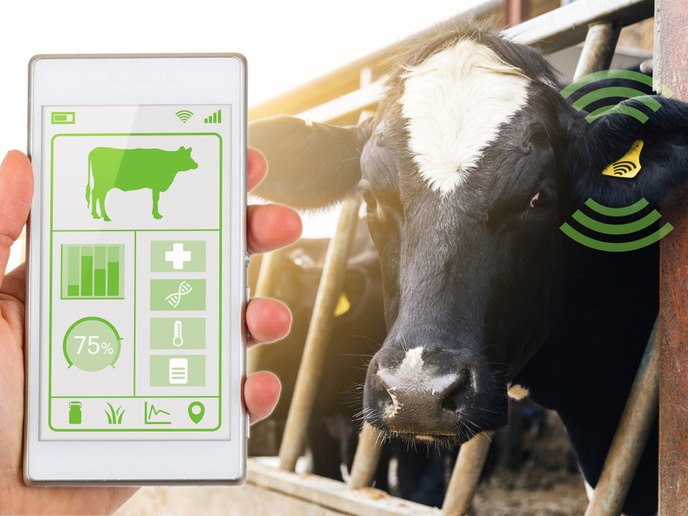Connected cows for better meat and dairy products
A new generation of farmers can easily feel as though they’re stuck between the devil and the deep blue sea. Remaining profitable means a push toward ever larger farms, and spending dearly on precision farming equipment to closely monitor meat and dairy product quality. This is enough pressure to discourage many wannabe farmers, but it’s also a must for those taking the leap. Only then can they quench governments’ and consumers’ thirst for transparency and traceability in the supply chain. With CATTLECHAIN 4.0 (Enhancing farm productivity and guaranteeing CATTLE traceability and welfare with blockCHAIN), Carlos Callejero and his team bet on new internet of things (IoT) devices and algorithms to provide a reliable and cost-effective solution capable of continuously monitoring single animals. Their technology, which has been validated in scenarios involving up to 5 000 cows, completely changes the way livestock is managed.
Can you tell us more about the IoT devices and algorithms you developed? What’s their purpose and what makes them particularly innovative?
Carlos Callejero: We combined IoT devices – collars and ear tags – and external sensors that weighed the animals and measured the amount of water they ingested. Our algorithms check the following animal welfare parameters: access to food, access to water and activity level (i.e. stress) of the animal. Eventually, some of the developed algorithms will work from the devices themselves (so-called edge computing) and therefore provide processed information that’s as close to the source as it gets. All in all, we can expect a future with smarter IoT devices that will capture more valuable information.
In what situations do these algorithms and devices come in particularly handy?
We have been working on three tools, each with its own purpose: a tool to monitor the amount of time an animal has been outside grazing, a tool to alert farms when the animal drinks less water than it should or has been gaining less weight than expected, and a tool to monitor stress levels and trigger notifications when they become abnormal.
What are the project’s main achievements so far?
Our new collars and ear tags are ready. They communicate with each other and have been proved to minimise the overall cost of herd monitoring. We have also successfully developed a new generation of algorithms using artificial intelligence to obtain more information on the state of the animal, as I already mentioned. This is all expected to increase the profitability of large herds. At the blockchain level, we came up with a tool that provides consumers with exhaustive information on the traceability of meat products. This tool has been validated with different farms selling their products directly to consumers. As you buy your meat, you get valuable information such as the place of origin, animal welfare certificates, etc.
What’s left to be done?
We have yet to launch our upgraded collar and ear tag with the edge computing capabilities I mentioned. With this new generation of devices, we hope to change the common perception among our customers that technology can only help with localisation. We are also working to improve the detection rates of reproductive events, as well as the grazing hour count algorithm. We want the latter to take into account variations induced by meteorological conditions. An algorithm to monitor nutritional activity during grazing will also be introduced. The last months of the project will be dedicated to the integration of blockchain technology within FIWARE – a community and framework of open source platform components that aims to accelerate the development of smart solutions – and including it in a pan-European decentralised network such as Alastria.
How can this technology help a younger generation of farmers thrive?
The European Green Deal will transform the EU into a modern, resource-efficient, and competitive economy. This is a challenge for the younger generations of livestock farmers. It calls for the development of management techniques and technologies that improve the efficiency and profitability of farms, all this respecting animal welfare and minimising the environmental impact associated with livestock activities. CATTLECHAIN anticipates these challenges with solutions helping young farmers face them and guaranteeing the longevity of their activity.
You’re working on an animal welfare seal as well. How do your tools provide a guarantee for this welfare?
IDELE (the French livestock Institute) are partners in this project. They provide expertise in animal behaviour and welfare. The Spanish institute IRTA is also subcontracted to set the thresholds beyond which incidents related to animal welfare have to be reported. Our objective is not to define those standards, it is rather to provide a technology that guarantees their application.
Can you tell us more about your commercialisation plans?
We’re planning for three distinct phases. First, we’ll focus on marketing efforts in Spain. The solution will be integrated into our distribution channels (web, commercial agents and distributors). Moreover, a promotional campaign will be carried out both digitally (social networks, website) and through our partners amongst livestock associations and cooperatives. Contacts with these associations and public administrations will also be intensified. The second phase will consist of consolidation in Spain and commercialisation in France, Portugal and the United Kingdom. Our marketing strategy will be replicated in the other two European markets where we are already present. Phase three is that of international marketing. We’ll be looking for a distributor in the main targeted markets, creating a network of resellers to better reach livestock farmers. We have already carried out this plan with other products in collaboration with telecommunications and technology providers.
Keywords
CATTLECHAIN 4.0, cattle, meat, dairy, ear tags, collars, IoT, precision farming, algorithms, traceability



